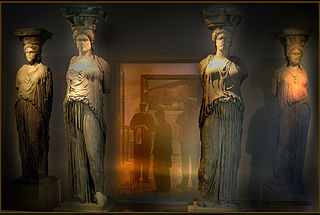The Odeon of Athens may refer to:
The Odeon of Athens may refer to:

The Acropolis of Athens is an ancient citadel located on a rocky outcrop above the city of Athens, Greece, and contains the remains of several ancient buildings of great architectural and historical significance, the most famous being the Parthenon. The word Acropolis is from the Greek words ἄκρον and πόλις. The term acropolis is generic and there are many other acropoleis in Greece. During ancient times the Acropolis of Athens was also more properly known as Cecropia, after the legendary serpent-man Cecrops, the supposed first Athenian king.

Ivo Livi, better known as Yves Montand, French:[ivmɔ̃tɑ̃]; 13 October 1921 – 9 November 1991) was an Italian-born French actor and singer. He is said to be one of France's greatest 20th-century artists.
Odeon may refer to:

The Odeon of Herodes Atticus is a stone Roman theatre structure located on the southwest slope of the Acropolis of Athens, Greece. The building was completed in AD 161 and then renovated in 1950.
Odeon, stylised as ODEON, is a cinema brand name operating in the United Kingdom, Ireland and Norway, which along with UCI Cinemas and Nordic Cinema Group is part of the Odeon Cinemas Group subsidiary of AMC Theatres. It uses the famous name of the Odeon cinema circuit first introduced in Great Britain in 1930. As of 2016, Odeon is the largest cinema chain in the United Kingdom by market share.

The Greek National Opera is the country's state lyric opera company, located in the Stavros Niarchos Foundation Cultural Center at the south suburb of Athens, Kallithea. It is a public corporation under the supervision of the Greek Ministry of Culture and administered by the Board of Trustees and its Artistic Director, currently George Koumedakis.

The Old Acropolis Museum was an archaeological museum located in Athens, Greece on the archeological site of Acropolis. It is built in a niche at the eastern edge of the rock and most of it lies beneath the level of the hilltop, making it largely invisible. It was considered one of the major archaeological museums in Athens. Due to its limited size, the Greek government decided in the late 1980s to build a new museum. The New Acropolis Museum is now built at the foot of the Acropolis. In June 2007 the old museum closed its doors so that its antiquities could be moved to their new home, which opened on 20 June 2009.

The Odeon of Agrippa was a large odeon located in the centre of the ancient Agora of Athens. It was built about 15 BC, occupying what had previously been open space in the centre of the Agora. It was a gift to the people of Athens by Marcus Vipsanius Agrippa, a Roman statesman and general.
Live at the Hammersmith Odeon may refer to:

The city of Athens during the classical period of ancient Greece was the major urban centre of the notable polis (city-state) of the same name, located in Attica, Greece, leading the Delian League in the Peloponnesian War against Sparta and the Peloponnesian League. Athenian democracy was established in 508 BC under Cleisthenes following the tyranny of Isagoras. This system remained remarkably stable, and with a few brief interruptions remained in place for 180 years, until 322 BC. The peak of Athenian hegemony was achieved in the 440s to 430s BC, known as the Age of Pericles.
Stefanos Korkolis is a Greek composer and pianist. He has performed in theaters and auditoriums all around the world, including the Concertgebouw, the Belém Cultural Center, the Royal Theater Carré, the Athens Concert Hall, the Thessaloniki Concert Hall, and the Odeon of Herodes Atticus.
Athens – Epidaurus Festival is an annual arts festival that takes place in Athens and Epidaurus, from May to October. It is one of the most famous festivals in Greece. The festival includes musical, theatrical and other cultural events.

The Odeon of Athens or Odeon of Pericles in Athens was a 4,000 m2 (43,000 sq ft) odeon, built at the southeastern foot of the Acropolis in Athens, next to the entrance to the Theatre of Dionysus.


Odeon or Odeum is the name for several ancient Greek and Roman buildings built for musical activities such as singing, musical shows, and poetry competitions. Odeons were smaller than Greek and Roman theatres.
Odeon Theatre or Odeon Theater or Odéon Theatre may refer to:

The landscaping of the Acropolis of Athens includes a system of paths and architectural interventions designed by Dimitris Pikionis, an architect and teacher at the School of Architecture at the National Technical University of Athens, in participation with his students, from 1954 to 1957.

The Pedestal, now known as the Agrippa Pedestal located west of the Propylaea of Athens and the same height as the Temple of Athena Nike to the south, was built in honor of Eumenes II of Pergamon in 178 BC to commemorate his victory in the Panathenaic Games chariot race. Its height is 8.9 meters. It was the base of a bronze quadriga, life-size, probably driven by Eumenes and/or his brother Attalus II. Towards 27 BC, this chariot was replaced by another one, dedicated by the city of Athens to Marcus Agrippa, son-in-law of Augustus, in recognition of the reconstruction of the Odeon of Athens in front of the Agora of Athens; it disappeared on an unknown date.